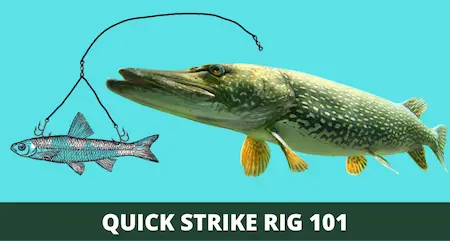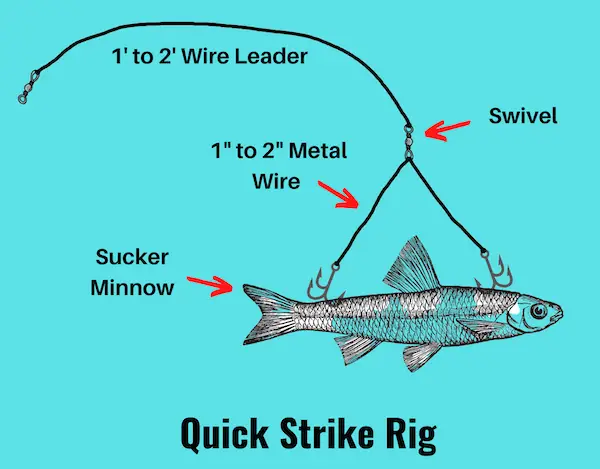Quick Strike Rig 101 (Setup and How-to Guide with Pictures)
PUBLISHED 19 JULY 2023
by Robert Ceran
Are you planning to use a quick strike rig for pike or muskie, but now sure how to set it up and fish it for the best results?
While the quick strike rig continues to be one of the best bait rigs for large northern pike and muskie, it requires a little know-how to use correctly.
In this article I’ll show you how to set up a quick strike rig, as well as the most important variations of this setup, and how to fish it for maximum success.

What is a quick strike rig (and what is it good for)?
This quick strike rig is a bait rig with two treble hooks designed for pike fishing, and comes with the advantage of allowing anglers to strike quickly after a pike takes the bait, hence avoiding deep hooking the fish.
The quick strike rig was originally created by European anglers, but has since been further developed by North American anglers. It works well for both northern pike and muskie fishing, and can be used with either dead bait or live bait.
How to set up a quick strike rig
There are 3 main variants of the quick strike rig, which differ substantially from each other, and which each have their own pros and cons.
To help you decide which of these is right for you, we’ll take a closer look at each of the modified versions, and how to set them up.
Traditional quick strike rig

The traditional variant of the quick strike rig is made with two size #4 to #6 treble hooks that are each attached to a 1” to 2” metal wire.
Both of these wires are then attached to the same eye on a barrel swivel (as shown in the image above). The second eye of the barrel swivel in turn attaches to a 1 to 2 foot long metal leader.
This version of the quick strike rig is most often used when ice fishing for pike, and has been in regular use for more than a hundred years, continuing to catch fish every hardwater season.
The most common use of this quick strike rig variant is with a dead bait fish, and a key advantage of its tandem hook setup is that it generates a horizontal presentation of a dead bait.
The reason for this is that if you poke each of the treble hooks through the head and the tail portion of a dead bait fish, this causes the fish to be suspended horizontally in the water.
In my experience, a horizontal baitfish presentation looks more natural to northern pikes, and results in more strikes.
You can make this quick strike rig by using tieable wire and pliers, you can also buy it pre-tied from many tackle shops and online retailers.
Modified quick strike rig for improved horizontal presentation

This version of the quick strike rig is made with a straight length of wire or heavy fluorocarbon line connecting the two treble hooks, as well as a third hook (a big circle hook) threaded onto the line or wire in between them.
The circle hook is ideally positioned to be poked into the gut of a dead fish, while the treble hooks are each poked into the baitfish near the tail and the head.
In addition to providing improved horizontal presentation of the dead baitfish, this setup also provides a second advantage. While a traditional version of the setup tends to spin when a pike tries to eat the bait, this modified version does not.
Modified quick strike rig for vertical baitfish presentation

The third variant of the quick strike rig is designed to present a dead bait fish vertically, with the head pointing downward, and the tail pointing up.
To be honest, most pike anglers prefer positioning their baitfish horizontally, but Canadian ice fishing legend Gord Pyzer claims that vertical baitfish presentation results in bigger fish.
Given that Gord has been pulling trophy northerns through the ice for more than three decades, I believe he knows what he’s talking about.
A key advantage of this version of the quick strike rig is that it’s even better than the traditional setup for avoiding deep hooked fish, and as you’re probably aware, a deep hooked fish stands slim chances of surviving after you release it.
So if it’s important for you to be able to release your trophy northerns or muskies alive and without critical injuries, I suggest giving this quick strike rig version a try.
Quick strike rigging with fluorocarbon vs metal wire
As already mentioned, traditional versions of the quick strike rig are usually made with a wire leader. However, wire is hardly invisible in the water, and can definitely scare off some fish. So an alternative approach that’s steadily gaining popularity is to use heavy fluorocarbon fishing line (60 to 80 lb test) instead.
The key advantage of using fluorocarbon for quick strike rigging is that it is almost invisible under water, and thus much less conspicuous than a metal wire. However, on the downside, no matter how heavy your fluoro, it can still be cut by the razor sharp teeth of a pike or musky.
If you do opt for a fluorocarbon quick strike rig setup, it’s advisable to set the hook as soon as you detect a bite, as this gives you a chance or setting the hook in the corner of the pike’s mouth, keeping the leader away from the sharp teeth.
Also, remember to check your fluoro leader for damage after every pike that you catch with your quick strike rig. You can do this by running your fingers along it to check for nicks and abrasions signaling that you’ll need to change it.
How to use a quick strike rig with dead bait
You can use any of the setup versions described above with a dead baitfish. Some anglers like to use oily fish such as herring, smelt or mackerel, but you can also opt for local freshwater fish, such as large suckers, shad, or even stocked trout.
If you’re using the quick strike rig for open water fishing, a great option is to suspend the rig underneath a large slip bobber setup, which comes with the advantage that it can help to cover a lot of ground as the bobber drifts with the wind and the current.
However, many anglers have found that static fishing works very well for northern pikes, as long as you position your bait along routes that they like to patrol, since the fish eventually find your bait there. If you want your bait to be presented close to the bottom, a great option is to use it with a Carolina rig setup.
And if you’re using the quick strike rig for ice fishing, one of the best options is to fish it with a tip up, as this will alert you as soon as a pike takes the bait. If you’re allowed to use multiple tip ups on your lake, you can position them along drop offs and weed edges, and test different depths to see what works best.
How to use a quick strike rig with live bait
In order to fish a live bait with this rig, use either the traditional quick strike rig, or the modified version for vertical presentation of the bait. Poke one treble hook through the back of the baitfish near the head, and the second one near the tail.
Keep in mind that a quick strike rig doesn’t give the baitfish much freedom to swim around, but it’ll still be able to wriggle enticingly in the water, which gives off vibrations that are very effective at attracting nearby pike.
But if you want to give the baitfish a little more freedom to move around, it’s better to use fluorocarbon for your quick strike rig instead of metal.
